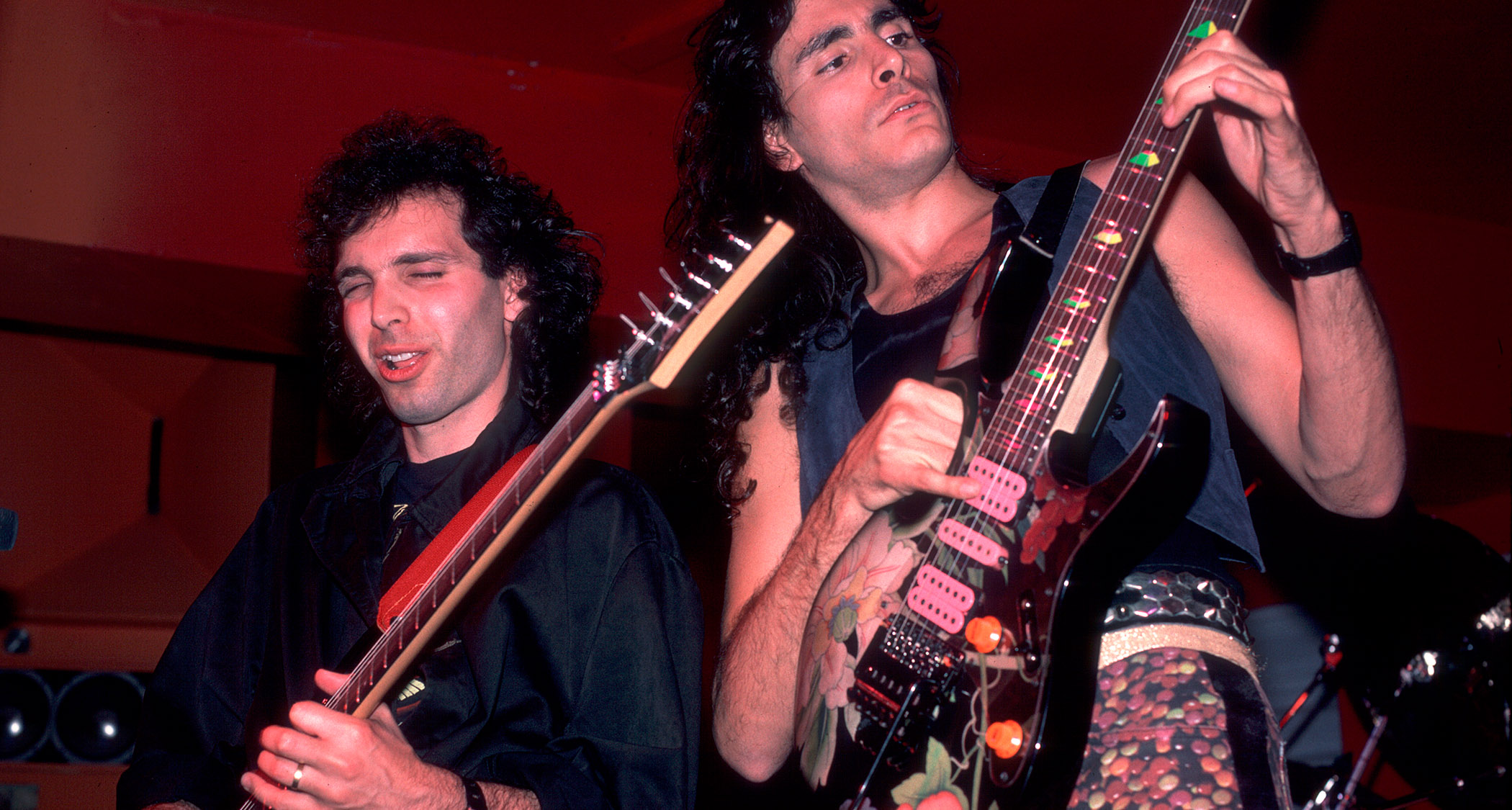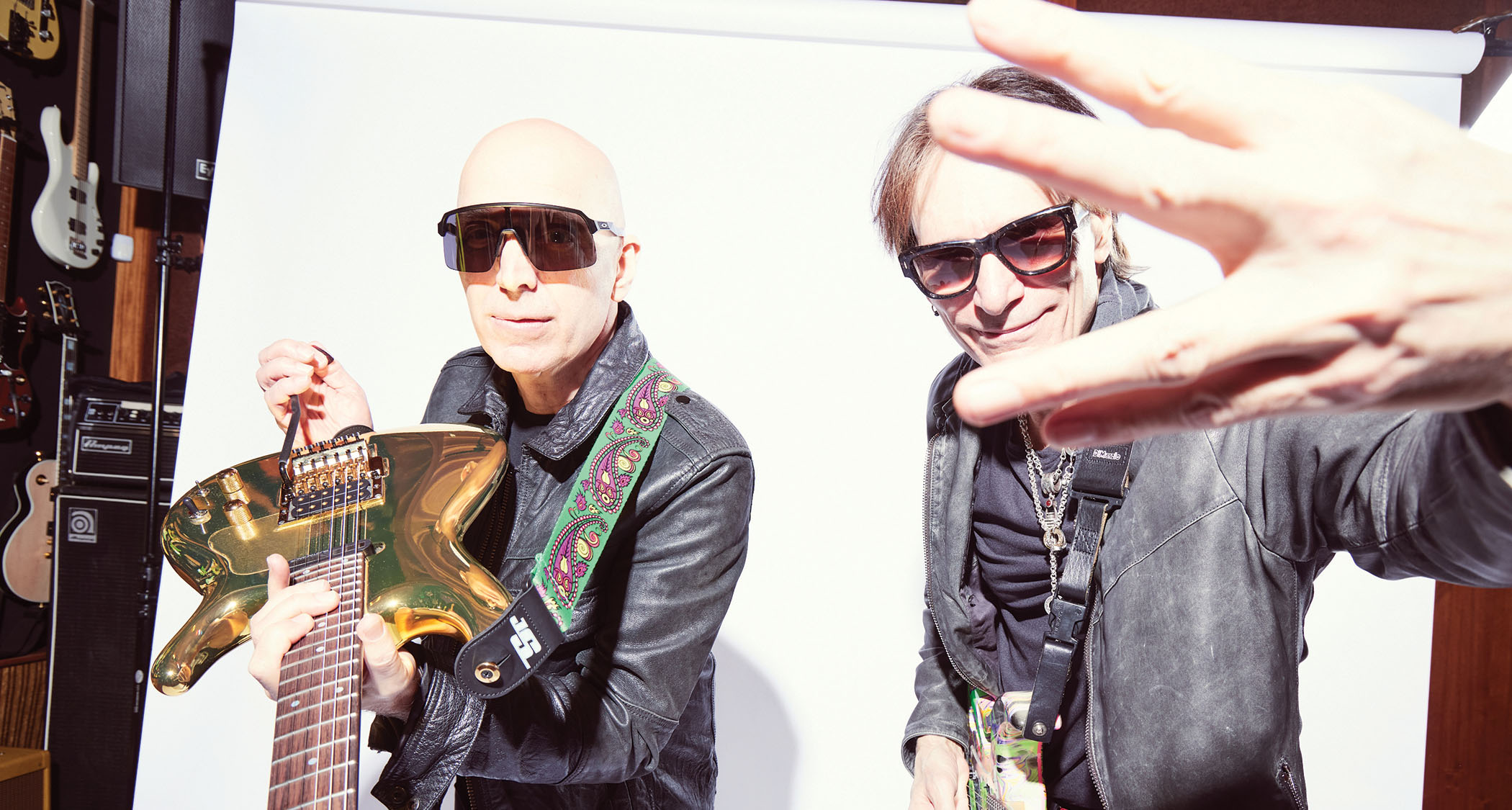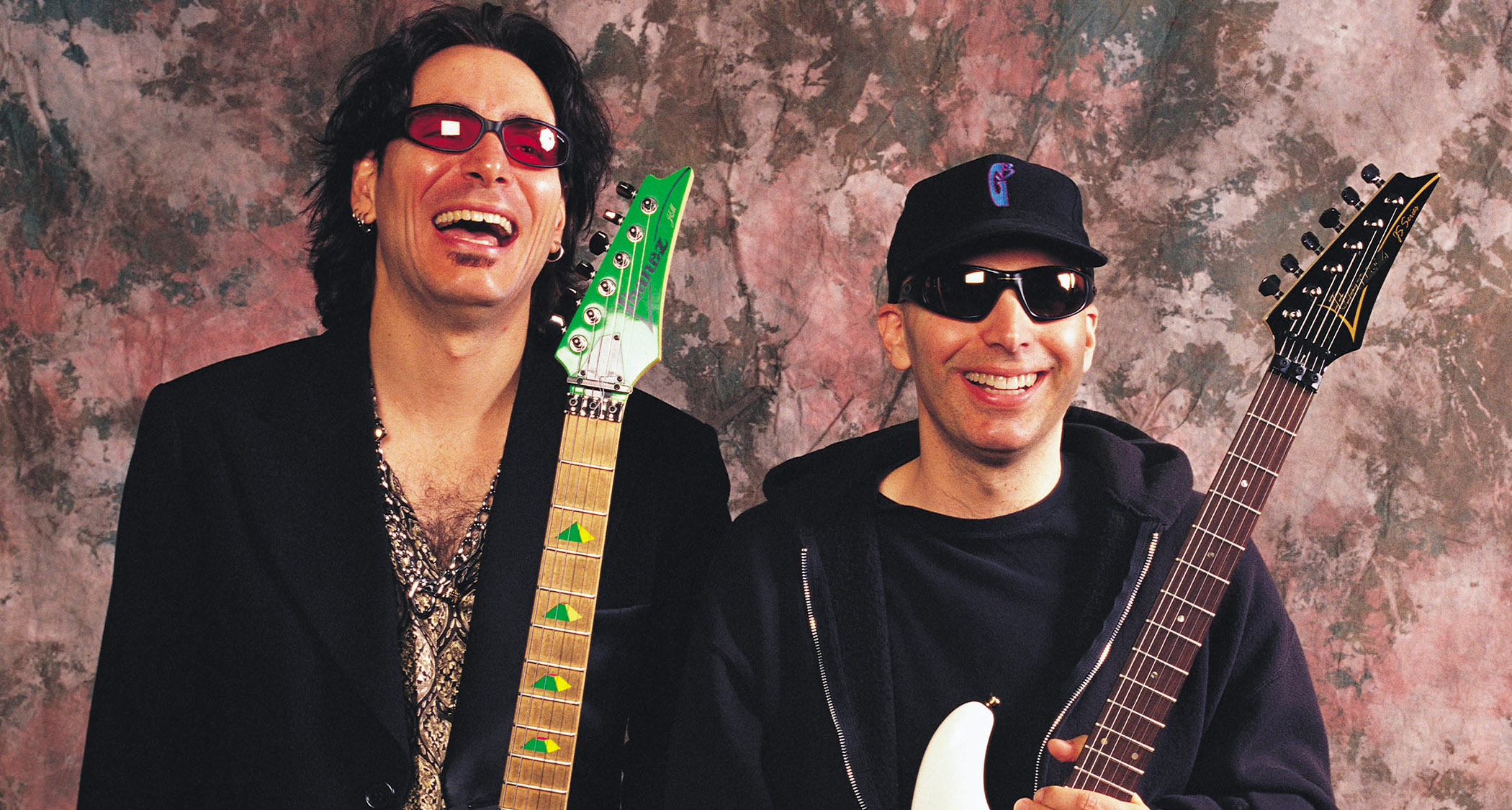
Joe Satriani still remembers the first time he laid eyes on Steve Vai. It was 1972 in Carle Place, Long Island, and at the time, Satriani, then just a teenager, was already known around the neighborhood as a killer guitar player – and maybe an even better guitar teacher.
Which is when Vai came knocking at his front door.
“It was your typical Long Island afternoon,” Satriani says. “I open the door and there’s this 12-year-old kid, a stringless guitar in one hand, a pack of strings in the other.” Suffice it to say, Satriani wasn’t immediately impressed.
“I really didn’t know him,” he says of Vai, “although I knew and feared his older siblings. When you’d see them walking down the hallway at Carle Place High School, you just moved to the side. Impressive family, you know?”
Satriani laughs, then continues. “So Steve shows up wanting to play guitar, and I think he knew about me because I had been teaching another local kid, John Sergio, who was Steve’s friend. John was a good guy and a really good student, and I probably never would’ve let Steve in the door had he not said John’s name. But I thought, ‘Okay, let’s see what this is all about…’”
Needless to say, anyone who has picked up a guitar or a Guitar World magazine – or, for that matter, has had even a nominal interest in guitar-based music – over the past 40 years knows what this story is all about.
Today, Joe Satriani and Steve Vai are two undisputed giants of the six- (and seven-) string universe. Their individual lists of accomplishments are too extensive, and by this point well-known, to spend time cataloging here, and it’s hardly hyperbole to say that there are few, if any, players in the post-Van Halen world that have been so influential, so successful and so beloved for so long.
Throughout the years, Satriani and Vai have remained the closest of friends, as well as each other’s biggest supporters and public boosters. They have each pushed not just guitar playing but guitar design into uncharted territories with their various Ibanez signature models (Joe’s expansive JS Series; Steve’s JEM, Universe and PIA ranges) and have taken similar leaps with their respective pickup collaborations with DiMarzio.
They have appeared on multiple Guitar World covers – on their own and together – and graced stages throughout the world alongside other guitarists on package tours like the long-running, Joe Satriani-conceived G3 (we recently resurfaced their first-ever joint Guitar World cover feature online).
Two things they have not done together? A co-headlining, just-the-two-of-’em tour, and writing and recording original music. But that all changes this year, as the pair have teamed up for the appropriately named Satch/Vai tour, a first-ever outing that sees the guitarists criss-crossing the U.S. for roughly three dozen performances.
What’s more, in preparation for the run, they’ve been working on something extra special: brand-new instrumental music that, at the time of Guitar World’s interview, they report is close to completion.
“It’s all right there, on my computer,” Vai says, pointing to a workstation behind him in his home studio. Adds Satriani, “We have three pieces that are 90 percent finished. We’ve both got ridiculous schedules, so we’re not even thinking about how impossible it is to get it done. But we’ll figure it out.”

Even after all these decades, these two remain fully engaged in their musical pursuits. Satch spent much of last year on the road in support of his 18th solo album, The Elephants of Mars, and is deep in woodshedding mode for the Best of All Worlds 2024 summer tour, where he will assume the herculean task of recreating Eddie Van Halen’s guitar parts alongside Sammy Hagar, Michael Anthony and Jason Bonham in a celebratory, VH-focused show.
As for Vai, he recently wrapped a mammoth globetrotting run for his 2022 studio effort, Inviolate, a record and tour that also saw him debut a brand-new, utterly mind-blowing guitar creation, the Hydra, a three-necked monster featuring, among other components: seven- and 12-string guitars; a four-string ¾-scale-length bass; 13 harp strings; single-coil, humbucking, piezo, MIDI and sustainer pickups; half-fretless necks; floating and hardtail bridges and much more.
Additionally, this past January, Vai and Satriani, along with Eric Johnson, embarked on a short G3 U.S. tour, reuniting the original trio that headlined the inaugural 1996 run.
Turning his attention to the Satch-Vai tour, Vai says, “I think in the back of our minds someplace, we felt it would’ve been kind of crazy not to eventually do something like this. Because while we’ve done G3 over the years, and we’ve been able to record some things together – a couple of guest spots here and there on various records – it’s never been just me and Joe before.”
As for their new collaborative music, he continues, “I think it’s all part of the path. And it just organically came about: ‘Hey, since we’re doing this tour, what if we fool around with some co-creations?’ And I’m very eager for the fans to hear these tracks. I think they’re gonna love them.”
I’m very eager for the fans to hear these tracks. I think they’re gonna love them
Steve Vai
“We’re having fun and getting it done,” Satriani adds.
“I’m just so glad it’s finally happening,” Vai says, then laughs. “Because by this point it’s something that has been percolating for, I would say, 55 years.”
To celebrate this 55-years-in-the-making moment, Satriani and Vai sat down with Guitar World to discuss their unique companionship and, now, collaboration. Over the course of a wide-ranging interview, the two expounded on their earliest days together, talked about their new tour and music and picked their favorite songs from one another.
They also looked at the state of the guitar community today, mused on how players can continue to “explore the infinite” and explained why, if you don’t know your guitar notes, you don’t know… well, you’ll see.
To state the obvious, you guys have known each other for a minute. But while you’ve crossed musical paths over the years, this is the first time you’ve ever done a co-headlining tour or released collaborative music. What led to this moment?
Joe Satriani: “It goes back to when my son, ZZ [Satriani’s son is an L.A.-based filmmaker], called me a few years ago about what was then the 25th anniversary of G3, saying he wanted to document it. Everything just sort of snowballed from there.
“We went into making the documentary, and then getting the idea to do a reunion tour [of the original 1996 G3 lineup with Satriani, Vai and Eric Johnson]. And then Steve and I and all of our people started saying, ‘Hey, we should just keep going.’
I know that, like me, Steve has production books laying around his desk with millions of ideas, and he’s always trying to figure out, ‘What year do I get to do this project?’
Joe Satriani
“The question was, how do we keep going? And that became, ‘Let’s do some shows… and maybe make some music too, while we can.’ So that’s how it started. Because I think we were pretty deep in our own worlds prior to that.
“I know that, like me, Steve has production books laying around his desk with millions of ideas, and he’s always trying to figure out, ‘What year do I get to do this project?’ We each just keep going in our directions until someone knocks on our shell and says, ‘Hey, come out and do something with somebody else.’”
Steve Vai: “Amen to that. And I thought it was perfect timing, really. Because this all started when we were kids, and it’s just been such a nice journey along the way. And Joe’s right – we both are very creative in the little secrets we like to manifest. But at this point we’ve done so much, and we’ve toured our own music by ourselves to the hilt. So you want to stretch out. You want to do some different things.”
Tell us about the new music you’ve been working on together.
Vai: “Well you know, there’s many ways to collaborate. I was out on tour for the last year and a half, basically, so it was a little difficult to wrap my brain around writing a song. But I opened my email one day, and there were these two absolutely delicious tracks that Joe had sketched, with quasi-finished parts. And they’re just so great.
“So we went back and forth on various arrangement concepts. Then he sent me the sessions with his solos in them. Oh my goodness. That’s a handful, I’ll tell you that. It’s amazing. Then there’s also one track that I kind of put together. Overall, I’ll just say that at this age, our true idiosyncrasies are really shining in the music. And I think the fans are going to love these tracks. They’re very ‘Joe and Steve.’”
Steve, this may be the first time you’re releasing music together, but it’s not the first time you’ve recorded any. Supposedly, there’s a two-track demo that you cut together as teenagers, after you had been taking lessons from Joe for 18 months. You guys called the recording Reflections on a Year and a Half.
Vai: “[to Satriani] Should I talk about that? “
Satriani: “Yeah, yeah, sure. Why not?”
Vai: “Well, I was taking lessons and I would walk into Joe’s room – and it was the coolest teenage Long Island bedroom ever, because it was festooned with huge rock ’n’ roll posters and beautiful stacks of vinyl, with Jimi Hendrix’s The Cry of Love usually at the front. And Joe’s Kustom amps – the ones with the kind of packing around the enclosure – and curly cables, which are always fascinating.
“But he had this two-track reel-to-reel recorder, and that was the first time I was exposed to anything in the world of engineering or recording or capturing music. And Joe explained to me, ‘Well, you can record something on one track and then overdub on another track…’
“I mean, that was like heaven in a cup. So in one of my lessons, Joe fired up this reel-to-reel. He had this riff, I had been playing for about a year and a half, and we recorded this thing. Just two kids in a bedroom. And it was a really cool, kind of interesting, hard riff.”

Satriani: “I think that was a Sony two-track I had?”
Vai: “Yep, it was. Go forward probably 15 years after that, Joe sent me the little reel and he said, ‘Look what I found.’ And it was the recording. I transferred it to digital, and it just sat on the shelf for many, many years. Until now. When the idea came to work on new music together, one of the tracks that Joe sent me has a part in it that is a chord progression that we used to jam over endlessly when we were kids.
“We’d go into his backyard and sit back-to-back for four, five, six hours and just play. It was the most amazing, engaging musical experience I can remember. And one of the chord changes we used to play on, Joe incorporated it into one of the new songs.
“So then I said, ‘I have this tape. What would happen if I took this and started to build something out of it?’ And that original recording is part of the contribution to the song I’m constructing.”
We’d go into his backyard and sit back-to-back for four, five, six hours and just play. It was the most amazing, engaging musical experience I can remember
Steve Vai
Satriani: “It’s amazing. It absolutely blew my mind. As soon as I heard the riff, I remember telling Steve, 'Oh, I remember that!' I was fascinated with the intervals and trying to figure out how to play something like that. And of course, after I heard it again I picked up the guitar and I was like, ‘What?’ It’s a really weird riff.”
Vai: “It’s obtuse. And you know, when I listen to the original tape I still don’t know who’s playing what. But I would assume that Joe’s playing the riff, because I don’t think I was capable of doing anything like that back then. [Laughs]”
Joe, what was it like having Steve as a student?
Satriani: “Well, my perspective on it is probably so different from his, as it is with all my students. When they come to me with recollections they remember things very clearly, and I rarely remember what they remember. I tend to remember a musical and a personality profile more than specific moments or individual lessons.
I remember about Steve is that there was a connection really early on, on a couple of levels
“But the most important thing I remember about Steve is that there was a connection really early on, on a couple of levels. One that I can’t really put into words, but just feeling really close to somebody that you’re meeting for the first time.
“The other was a really important lesson to have as a young guitar player – and something you don’t want to really think about when you’re a teenager and dreaming of becoming a rock star – which was having some little kid come in and totally blow you away, where pretty soon you’re going, ‘Oh, man, this kid’s got more than I’ve got.’ [Laughs] That’s what it was like with Steve. I mean, I’m still struggling with that riff in Reflections [on a Year and a Half]. It’s not getting any easier!”
Steve, you’ve said that at one of your first lessons with Joe, he actually sent you home.
Vai: “Yes. And trust me when I tell you this was probably one of the most powerful, transformative events in my life, because it wasn’t just a simple surface-level kind of a suggestion. It went very deep. And Joe probably has no idea how deep. But we have a tendency to create identities for ourselves based on what the world is telling us about ourselves.
“And when I was young and going to school, I was never very sharp or bright in academics, you know? So I never really felt I had the ability to memorize things. I didn’t want to do anything except play the guitar. But I went to this one lesson and Joe said, ‘Memorize every note on the guitar. And when you come back, you’ve gotta know it.’”

“It’s interesting, because when I was leaving his house, in the back of my mind was this old belief: ‘You’re not gonna do that. You can’t. You don’t have the retention or the intelligence to memorize all those notes and know them immediately.’ It was a disbelief in myself.
“So then I went back for my lesson the next week, and I hadn’t learned the notes. I sit down, and Joe goes, ‘Stop. Go home. Don’t come back until you know the notes. And thank you very much – I’ll take your money.’ Which is another absolutely necessary thing that I needed to understand. [Laughs]
“And I still remember on my lesson sheet from that day, he wrote, ‘If you don’t know your notes, you don’t know sh—!' That’s the way he wrote it: S, H, space, space, exclamation point. And then a little picture of a dagger.”
I remember on the walk home from Joe’s house I had an epiphany: ‘You are never, ever going to step into that house again until you know your lesson so hard.’ And also, ‘You can do it‘
Steve Vai
Satriani: “[Laughs] The dagger part… I mean, can you imagine if a teacher did that today?”
Vai: “But like I was saying, that experience was transformative. I remember on the walk home from Joe’s house I had an epiphany: ‘You are never, ever going to step into that house again until you know your lesson so hard.’ And also, ‘You can do it. Why do you think you can’t? Of course you can memorize the notes. As a matter of fact, you’re gonna know the notes so cold that you’re never going to forget ’em.’
“It was a complete reversal of my perspective of myself. And that flowed into everything that happened in my life afterwards. I know it sounds like a lot, but it was that memorable.”
What we’ve been talking about here is the forming of a deep bond between two musicians. Jumping forward a bit, you recently wrapped a short G3 tour, which recreated the initial lineup from 1996. Joe, when you conceived the G3 idea in the mid-‘90s, it came out of the desire to foster more of those types of bonds within the guitar community, correct?
Satriani: “Yes. Nowadays we have the internet, we have social media. But the idea behind G3 came from the fact that things were very antisocial, I suppose, in our world. That was my perspective, at least. There was a lot of competition, a lot of back-stabbing, a lot of stupid, old-school entertainment rules that were keeping guitar players away from each other. I noticed that there wasn’t any camaraderie at all. And I said, ‘Well, there should be.’”
I noticed that there wasn’t any camaraderie at all. And I said, ‘Well, there should be.’ We wound up on our separate islands, protected by our labels and managers, and nobody was playing together
Joe Satriani
“I think that’s what Steve and I were thinking about when we were kids playing in my backyard. We thought, ‘This is gonna be great when we’ve got a few more of us, and we’re all traveling around the world, playing on stages, having a great time showing each other how to play this, that, and the other thing.’ But it didn’t happen that way. We wound up on our separate islands, protected by our labels and managers, and nobody was playing together.
“Also, I think the styles of rock music that were popular in the early ‘90s didn’t really help solve that issue at all. So I started to feel like, ‘Hey, maybe we should formalize something that guitar players feel is a safe, fun place not only for them, but for the audience that loves this stuff. Where we can have fun with the guitar and celebrate it, rather than compete with it.’ That was really at the heart of G3. And it took some convincing because, you know, the ‘90s were the ‘90s.”

Do you feel that the guitar community is in a better place nowadays?
Satriani: “Now it’s fantastic, because so many players have a venue. As a matter of fact, every player has their own venue. It’s a total democracy out there, and it’s so easy for players to interact with one another.
“If you spend 24 hours on social media checking out every guitar player from every corner of the world, your mind will be blown. And hopefully it won’t make you give up. Hopefully you go, ‘I’m inspired now.’ Because, really, what the internet is telling us is that everyone is an individual and everyone has something unique to say. So you should take it all as encouragement.”

Vai: “It’s hard for a lot of people to understand what it was like before the internet – even though it’s like yesterday to us – but the whole infrastructure of the music business was completely different. You had to spend a lot of money on renting a studio to record. You had to have a label interested in investing in you and releasing your music. You had to have agents that were willing to book you based on promoters taking a chance.
When Steve was sending me little video clips of him in the studio playing the Hydra, in my head I could see the little 12-year-old kid sitting in my bedroom taking his lessons. And then I thought, ‘Yeah, this makes sense. I totally expected this!’
Joe Satriani
“These days, you can release your own music. You can build your own story. If you have the wherewithal, you can be completely independent. It’s really wonderful the way it’s changed. And as a result of that, you’ve got people who are sitting in their bedrooms motoring away, and then uploading videos and allowing all of us to bear witness to what’s possible on the instrument. And that’s encouraging and inspiring.
“What I would also love to see happen, because there’s one aspect that’s missing from that, is the personal, intimate connection with another musician in the moment. I would love to see technology evolve to the point where it’s as easy to enter that space with somebody else as it is to just sit alone. Because there’s a big difference between sitting alone or connecting with somebody. But I think that’s on the way.”
Here’s a “Joe and Steve” question: Do each of you have a favorite song from the other?
Satriani: “Oh, wow. [looks at Vai] What was the first tape that you sent me? What was it called? It was the one that had Garbage Wrapped in Skin and all that stuff on there. This is before [Vai’s 1984 debut solo album] Flex-Able. I loved that.”
Vai: “I had, like, a little bossa nova drum machine that [Frank] Zappa gave me, and I didn’t know what I was doing. I would just hang a mic in front of the [speaker] cabinet. I was fascinated with the idea that I could go woo woo woo woo and then hear it back. It was nasty stuff.”
Satriani: “You would feel dirty after listening to this stuff! [Laughs] But then you’d go, ‘How crazy is this person to create this soundscape?’ It was like stepping into an insane film, you know? It was so inspiring to see Steve get into that space, to be able to create a world. And of course he refined it, and then he made it beautiful. But it’s hard to pick just one song.
“There’s For the Love of God [from 1990’s Passion and Warfare], which is such a monumental piece of music. And I’m really into the most recent album [Inviolate], because it’s so expansive – in addition to the three-necked beast that he plays on it. When Steve was sending me little video clips of him in the studio playing the Hydra, in my head I could see the little 12-year-old kid sitting in my bedroom taking his lessons. And then I thought, ‘Yeah, this makes sense. I totally expected this!’”
How about you, Steve?
Vai: “Oh, there’s so many tracks of Joe’s that I love. There’s a side of me that just loves listening to anybody play guitar, regardless of the proficiency, and then there’s the critical side of me that listens to guitar players with the same ears that listen to, you know, Jeff Beck and Allan Holdsworth. I’m checking out form, intonation and style.
Joe’s always been so eloquent in expressing his real musical intentions. I equate him to Tom Waits, in a sense. Tom is just my favorite artist, and it’s because he creates these atmospheres
“But the thing that always resonates with me, no matter what, is inspired melody – melody that comes from a place that’s unique and intimate to its creator. And this is Joe’s world. He’s always been so eloquent in expressing his real musical intentions.
“I equate him to Tom Waits, in a sense. Tom is just my favorite artist, and it’s because he creates these atmospheres, and every element of the atmosphere works within the overall picture. Joe does the same thing. Completely different tools, obviously, but similar outcome.
“With that in mind, the song of Joe’s that I’ll mention is Cryin’ [from Satriani’s 1992 album, The Extremist]. Just for the way that melody is so touching. You don’t need those Matteo Mancuso-like chops to get the point across, you know? The melody, and the way Joe plays it, it’s just sublime. I get lost in it every time I hear it.”
Turning our attention back to the upcoming Satch-Vai tour, what can fans expect to see that they haven’t seen before from you two?
Satriani: “Well, for starters, we’re going to be performing original music together, which is something we haven’t really figured out as far as the staging part of it. But, you know, if we build it, it will come. And that’s kind of like the way I’m looking at it.
“We’ve written the music, we’re getting it recorded, and then once it’s recorded, we’ll figure out how to play it. Then once we know how to play it, we’ll figure out where it goes in the show, and so on and so forth. But I never worry about those details beforehand. Because then you wouldn’t do anything.”
The G3 shows are fantastic, but they’re more about the communicative back and forth. This is more like our DNA fused together
Steve Vai
As far as the staging goes, I envision Joe’s bedroom circa 1972 – the posters, the Cry of Love vinyl, all of it.
Vai: “That’s right! Do the whole thing – us sitting back-to-back, using curly cables and Kustom amps.”
Satriani: “I’ll have to get a wig…”
Vai: “[Laughs] But the new music is one of the things I’m looking so forward to. Because I think the fans will see something that wasn’t really represented as much in-depth before, and that’s us playing organized, written lines that aren’t just simple melodies.
“I mean, there’s some simple melodies, of course, but really, we’re going to have to sharpen our teeth on playing these beautiful tapestries together. And that’s different from, say, G3. The G3 shows are fantastic, but they’re more about the communicative back and forth. This is more like our DNA fused together.”
Since those days in Joe’s Carle Place bedroom you’ve both accomplished so much in your respective careers. And as we’re seeing now, you’re still trying new things. Where does that desire to continue exploring with your instrument and your music come from?
Vai: “I think it’s built into us by universal design – to want to achieve, to want to explore, to want to expand. The creative impulse in humans is very powerful, and it has a momentum to it. I know that for me, that has never gone away.
With elite athletes, virtuoso musicians, what have you, there’s certain limitations. I know I’ve experienced some physical things over the years. But still, within any parameter you can explore the infinite
Steve Vai
“I used to create lists and lists of projects I wanted to do, and I remember when I turned 50, I looked at this list and I realized there were maybe 150 projects on it. And each one of them takes two years, you know? And I was like, ‘Okay…’ I realized that as long as I’m enjoying what I’m doing in the now, then all will be well. So that’s what I continue to do.
“And that’s also keeping in mind that, through time, there’s changes. Especially with elite athletes, virtuoso musicians, what have you, there’s certain limitations. I know I’ve experienced some physical things over the years. But still, within any parameter you can explore the infinite. Even if you have one finger, it’s all there. So with that attitude, I’ve learned to adjust, but go deeper. That’s always been my goal, and it continues to be.”
How about you, Joe?
Satriani: “I maybe noticed my physical limitations quite early on. [Laughs] But one thing I really took to heart was what I learned from Bill Westcott, our mutual music theory teacher at Carle Place High School. Bill was the one who said to me, ‘You know, when you’re 18, 19, it may turn out you’re not really very gifted, physically, on the instrument. But it doesn’t mean that your brain can’t keep developing until you’re 80 years old.’
I’m 67 now and I still play arpeggios exactly the same way now as I did when I was 17. There’s been zero progress. Zero!
Joe Satriani
“He said, ‘That’s what you should be training – the musician up here [points to his head]. Then your hands will follow.’ That’s really hard for a teenager to understand, because at that time in your life it’s all body, you know? It’s just hormones and flesh and blood. And then someone says, ‘No, don’t pay attention to your body – think!’ [Laughs] It took a while, but I realized Bill was so right-on with that.”

Vai: “Bill was totally brilliant. So much of what I learned about music theory was fed by Bill, but at the time I wasn’t applying it to the guitar. Joe was taking the same class from the same teacher, and he was able to apply this musical information to his instrument.”
Satriani: “What I discovered through that was that composing was the thing I liked the most. As much as I liked playing, I really liked writing music. I was intrigued with harmony. I was dead-set on turning it upside down, and playing chord progressions that no one had thought of, and breaking the rules of, you know, 18th-century counterpoint and everything else.
What I discovered through that was that composing was the thing I liked the most. As much as I liked playing, I really liked writing music
Joe Satriani
“But that wasn’t going to come from my fingertips or what size pick I was using. It was going to come from how my brain was going to interpret my feelings about what I wanted to express musically. That’s a really long game to play. To embark on that journey of composing is the longest game ever. Because it keeps going.
“And as Steve said, it may turn out you’ve just got one finger left, but you can still write the greatest thing ever. So that’s been my focus right from the beginning. The rest of it is just fun. And also annoying, because I’m 67 now and I still play arpeggios exactly the same way now as I did when I was 17. There’s been zero progress. Zero!”
Vai: “Oh, I don’t know about that. [Laughs] You should hear you through my ears.”







